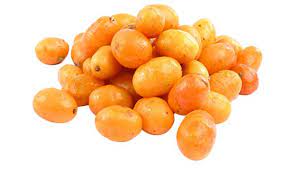Generally, fruits are an excellent source of essential vitamins and minerals, and they are high in fiber.
Fruits also provide a wide range of health-boosting antioxidants, including flavonoids. Flavonoids are a group of plant metabolites thought to provide health benefits through cell signaling pathways and antioxidant effects.
These molecules are found in a variety of fruits and vegetables. Scientific studies have shown that eating a diet high in fruits and vegetables can reduce a person's risk of developing heart disease, cancer, inflammation, diabetes and many other disease conditions. One such fruit is the yellow mombin fruit whose health benefits are explored in this piece.
Yellow Mombin
Yellow mombin is a plant species and a flowering plum hence it is also called hog plum. However, its botanical name is Spondias mombin. Biologically, yellow mombin belongs to the Anacardiaceae family within the plantae kingdom.
Yellow mombin is found in Asia, Africa, tropical Americas including West Indies. It is believed that yellow mombin was introduced by the Portuguese in South Asia in the beginning of the 17th century. The plant is rarely cultivated even though it propagates through seed and stem cutting. The mature fruit has a leathery skin and a thin layer of pulp, and it is found that the seed has a 31.5% oil content.
The yellow mombin plant is a small deciduous tree usually about 20m high and it is moderately buttressed. It has a thick bark and the flowers are sweet-scented, in large, lax terminal panicles of small white flowers.
The fruits mostly appear from July to September, and they are nearly long, ovoid yellow, acid and wrinkled when dry. The fruits have a sharp, somewhat acid taste and are edible. Their flesh surrounds a single spiny kernel. Due to their acidic nature, yellow mombin fruits can cause tooth sensitivity when eaten in large quantities.
Ghanaian Names for Yellow Mombin
To make this discussion more meaningful and useful, it is important to identify certain local names for yellow mombin in Ghana and other places so that readers can relate, methinks.
In Ghana, yellow mombin is called Akukor in Ewe whereas in Ashanti Region, it is called atoa or Ashanti plum. Fantes and Gas refer to yellow mombin as ataaba and aadon respectively. In French, however, yellow mombin is called prunier mombin.
In Nigeria, yellow mombin is called Yeye in the Yoruba language whilst the Igbo speaking people call it Ngulungwu and in Hausa, the same plant or fruit is called Isada.

Yellow Mombin Fruits
The ripe fruits or pulps are usually eaten fresh, or their juice is extracted for drinking. In view of its sweetness, yellow mombin ferments hence some people use it to distillate akpeteshie. My father, the late Torgbe Dedzi Ngorgbier Korto used to brew alcohol out of yellow mombin at Mepe in Volta Region’s North Tongu District.
Medicinal Values and Health Benefits
In recorded history, medicinal plants have been in use for the treatment of human and animal diseases (Osai, 1998; Ibewike et al, 1997). A plant becomes a medicinal plant only when its biological activity has been ethnobotanically reported or scientifically established (Elujoba, 1997).
In 1978, the World Health Organization (WHO) emphasized the importance of scientific research into herbal medicine. Since then, many countries of the world look upon native medicinal plants as possible addition to the WHO’s list of “essential drugs” once the values the former have been clinically proven to be efficacious.
A simple first-principle biological technique in the evaluation of plant with no known biological activity is to conduct a screening test (Elujoba, 1999). Spondias or yellow mombin has variety of medicinal values in traditional medicine in countries where the plant is indigenous.
According to Echeme et al (2014), the bark of yellow mombin tree is used both as a purgative and a treatment for leprosy and that the bark decoction (extraction) is also used in the treatment of severe cough.
Some other researchers (Ayoka et al., 2008) also found that yellow mombin serves as an emetic (vomitive), a remedy for diarrhoea, dysentery and treatment for gonorrhoea and eucorrhea (vaginal discharge).
In another study, Nworu et al (2011) found that the leaf extract of yellow mombin displays an anti-inflammatory effect and suppresses inducible formation of tumor necrosis factor-α and nitric oxide (NO). In the traditional medicine of Africa and Latin America for example, yellow mombin extracts are used to treat many inflammatory conditions, with repeated claims of efficacy.
Quite commonly, a tea (made from the flowers and leaves) is taken to relieve stomach aches, biliousness, urethritis, cystitis, as well as to ameliorate inflammation of the eye and/or throat (Ayoka et al., 2008). For ease of reference regarding medicinal or health benefits of yellow mombin, I culled the table below from Ayoka et al. (2008: 132)
| S/N | Morphological Part | Medicinal Uses |
| 1 | Root | Decoction as purgative |
| 2 | Bark | Decoration as emetic, a remedy for diarrhea, dysentery, haemorrhoids and a treatment for gonorrhoea. In Mexico, it is used to expel calcification from the bladder, powder for healing wounds |
| 3 | Gums | Expectorant and to expel tapeworm |
| 4 | Leaves | Tea with flower relieves stomach ache, biliousness, inflammation. Decoction of the young leaves is a remedy for diarrhea and dysentery. Juice of crushed leaves and powder of dried leaves on wounds and inflammations and abortifacients |
| 5 | Fruit | Juice drink as diuretic and febrifuge |
| 6 | Flowers | Tea with flower relieves stomachache, biliousness, urethritis, cystitis and eye and throat inflammation |
Conclusion
Arguably, human survival and continued existence in turn depends on the efficiency with which we, with all the resources and technology available to us, harness, develop and utilize plants and plant products. This piece depicts various empirical findings that demonstrates that yellow mombin (Akukor) is a medicinal plant with a lot of potential, valuable, untapped resource of active drugs for treating diseases. I dare challenge Ghanaian plant medicinal researchers to explore the medicinal potentials of this plant, yellow mombin.
~Asante Sana ~
The author is a Health Service Administrator at Ga South Minicipal Hopsital- afetikorto@yahoo.com
Latest Stories
-
Photos: Mahama swears in newly appointed Military Service Commanders
59 seconds -
Prosecute military officers responsible for Nyinahini killing – Chief
9 minutes -
TTH doctors resume emergency services after Dagbon Overlord’s intervention
31 minutes -
President Mahama declares 1st July as National Day of Prayers and Thanksgiving
1 hour -
Newborns to receive Hepatitis B vaccinations from October
1 hour -
ASFC 2025: Ghana boys to fight for bronze after defeat to Tanzania
1 hour -
Why more Nigerians will fall into poverty by 2027 – World Bank
1 hour -
NDC parliamentary caucus will not interfere in YEA-Zoomlion contract – Ayariga
1 hour -
Marietta Brew chairs new UG Governing Council
2 hours -
Koby Maxwell laments drop in Ghanaian music standards
2 hours -
Pastor remanded for allegedly publishing falsehoods about Prophet Adom Kyei-Duah
2 hours -
Marietta Brew chairs new UG Governing Council
2 hours -
Community leadership at the forefront of the Global HIV Strategy for Africa’s future
2 hours -
Sudanese eating charcoal and leaves to survive, aid agency warns
2 hours -
Thaddeus Sory writes: Bin the cacophony — Trust the process
2 hours

